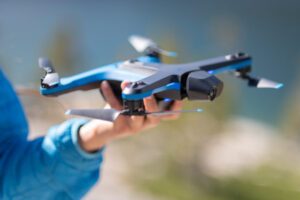
U.S. Drone Manufacturer Skydio Announces They Will Sunset Consumer Drones
US drone manufacturer Skydio has announced that they will sunset their consumer drone business to focus on the enterprise market.
Continue reading below, or listen:
In a blog post by Skydio CEO Adam Bry published today, the company revealed that it will discontinue its consumer drone line to prioritize its offerings for the enterprise and public sector. This decision comes four years after the launch of the Skydio 2, a drone that gained attention for its unique features like follow-and-film capability and autonomous cinematography.
As the drone industry has evolved, Skydio has found the commercial and public sector market growing quickly, as demand for domestic drone products rises over continued concerns over Chinese-manufactured technology for military and state use. Skydio was one of the initial drones granted Blue sUAS status, and has continued to successfully leverage their designation as a secure platform combined with the ease of use provided by Skydio’s flagship autonomy platform to gain market share across large enterprise, public safety, and federal agencies.
Adam Bry acknowledged the difficulties in making the decision to abandon the consumer market, recognizing the impact on the existing user base. Despite the pivot, Skydio promises to maintain software updates, customer support, warranties, and repair services for its consumer customers in line with their existing warranty commitments. The company also intends to keep accessories available for the foreseeable future.
As part of its new direction, Skydio has introduced the Skydio 2+ Enterprise Kit, aimed at catering to the needs of commercial enterprises and public sector organizations. The kit is presented as a tailored solution for sectors with critical applications, such as public safety and defense.
A notable addition to this announcement is Skydio’s assurance of Remote ID compliance for existing consumer drones. Remote ID will be required in almost all drones on September 16, 2023. According to the company’s FAQ document, Skydio enabled Remote ID on drones produced on or before September 16, 2022, using a software update and label.
The move away from consumer drones marks a significant shift in Skydio’s trajectory from inception: but it is clearly backed by the numbers. In February of this year, Skydio announced the successful closure of a substantial $230 million Series E funding round, catapulting its total funding to an impressive $562 million. In addition, Skydio unveiled a state-of-the-art 36,000 square feet manufacturing facility in Hayward, CA in response to escalating product demand. Skydio now claims integration within every branch of the U.S. Department of Defense, over half of the U.S. State Departments of Transportation, and more than 200 public safety agencies across 47 states. The brand also has a rising profile in energy utilities and other enterprise sectors.
Read more:
- Skydio Donates Drones to Ukraine for Documentation of Russian War Crimes
- Southern Company Gets BVLOS Waiver for Fully Remote Drone Operations with Skydio Dock
- Skydio Dock, Remotely Operated Drones Get Major Win in Japan
- Skydio AI-Empowered Drone Self Navigates in Flight Over Sydney Harbor, with First Deployment of Skydio Dock in Australia
- Skydio Partners with gNext for Drone Infrastructure Inspection
- Skydio Funding: $230 Million to Expand U.S. Manufacturing, Hiring

Miriam McNabb is the Editor-in-Chief of DRONELIFE and CEO of JobForDrones, a professional drone services marketplace, and a fascinated observer of the emerging drone industry and the regulatory environment for drones. Miriam has penned over 3,000 articles focused on the commercial drone space and is an international speaker and recognized figure in the industry. Miriam has a degree from the University of Chicago and over 20 years of experience in high tech sales and marketing for new technologies.
For drone industry consulting or writing, Email Miriam.
TWITTER:@spaldingbarker
Subscribe to DroneLife here.







[…] Skydio Shifts Focus: Transitioning Away from Consumer Drones […]